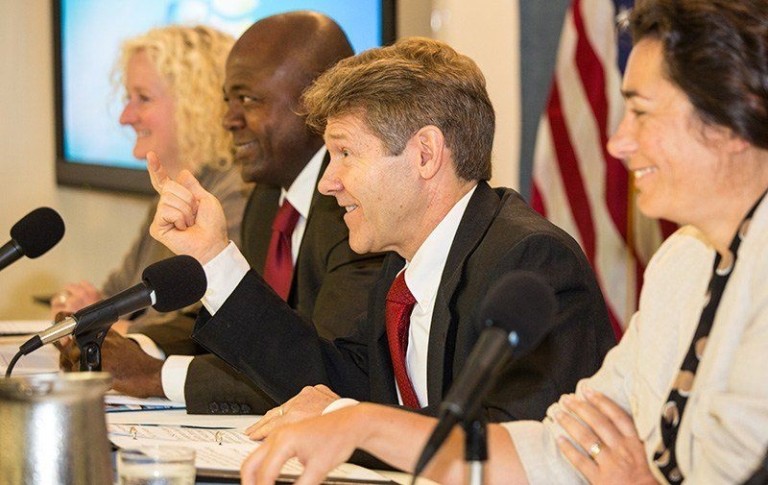Blog
Pact, partners reach critical milestone in mineral traceability in Africa

While work remains, Pact and its partners have made significant progress implementing a traceability and due diligence system in the Great Lakes region of Africa to assure minerals as conflict-free, experts said during panel discussions marking five years since the United States adopted legislation meant to stop conflict minerals.
Pact hosted two discussions July 14 in Washington D.C., to provide legislators, the media and other stakeholders with up-to-date information about iTSCi, the only widely implemented and accepted mineral traceability and due diligence system in the region for the 3T minerals – tin, tantalum and tungsten.
The same day, Pact released a detailed report about iTSCi’s progress over the last five years. Entitled Unconflicted: Making Conflict-Free Mining a Reality in the DRC, Rwanda and Burundi, the report examines the unprecedented effort to track to market hundreds of thousands of kilograms of minerals in one of the most challenging environments in the world. It discusses successes to date, challenges that lie ahead and work left to be done.
Pact implements the iTSCi system with ITRI (the international tin association) and the governments of the Democratic Republic of Congo, Rwanda and Burundi. Besides providing a means for U.S. companies to comply with the 2010 Dodd-Frank Act, which requires them to show that the 3T minerals in their products did not fund conflict, iTSCi has safeguarded the livelihoods of more than 80,000 artisanal miners with few other options for earning a living.
The 3T minerals are needed to make everything from smartphones and computers to medical devices and airplanes, and a large portion of the world’s tantalum supply is mined from the Great Lakes region – the only area to which the Dodd-Frank Act applies.
Understanding the complexity of mineral traceability is especially important right now because additional governments are considering their own conflict minerals legislation, including the European Union and Canada, panelists said.
Panelist Kay Nimmo, with ITRI, said the association began working on a traceability system before Dodd-Frank because industry anticipated the need.
“But Dodd-Frank created a very big incentive” to quickly get the system up and running at as many mine sites as possible, Nimmo said.
The legislation initially was seen in the region as a colonial-style imposition, as a penalty and even as an effort to divert mineral trade to competitor markets, said Yves Bawa, Pact’s regional director for the DRC, Rwanda and Burundi.
Without a functioning, credible traceability system, Dodd-Frank amounted to a de facto embargo that threatened to put already impoverished artisanal miners out of work, said Jean-Paul Meutcheho, director of corporate sustainability and sourcing at Global Advanced Metal.
The iTSCi system involves bagging and tagging ore and then closely tracing and weighing each bag at various points along its path to market, explained Karen Hayes, who heads Pact’s Mines to Markets program.
Hayes described the complexity of implementing such a system from scratch at remote, dangerous mines far from paved roads in a region rife with conflict and instability. Before iTSCi, no one had mapped or even counted active mine sites, Hayes said.
The launch of iTSCi was only possible, she said, because industry, governments and development organizations worked together.
Today, the iTSCi system is in place at more than 800 active mines, including many that were once thought too remote or too insecure to be reached.
Because of iTSCi, panelists said, more than 80,000 small-scale miners have access to legal markets for their production, for which they’re now paid higher prices. Local economies are stronger, generating tax revenue for development. And while no traceability system can solve conflict, iTSCi has built cross-border cooperation among the governments of the DRC, Rwanda and Burundi, and it has created “hubs of safety and stability” at mines sites, Hayes said.
The system has also vastly improved conditions for artisanal miners. Government agents now oversee mines that before were not on record. Work sites have been de-militarized, Hayes said, and human rights abuses are documented and addressed.
In addition to its traceability work, she said, Pact has begun overlaying health, safety and education programs at mines in the Great Lakes region to improve the lives of people who depend on the arduous occupation.
While the Pact report notes that the organization did not support the adoption of Dodd-Frank and was deeply concerned about its immediate effects, it states, “We are now the first to say that it has had a profoundly important impact in the region.”
As for what lies ahead, panelists said it is critical that any new legislation matches current requirements because industry cannot reasonably be asked to pay for multiple sets of compliance.
Also vital is donor funding, panelists said. Although iTSCi is self-financed through a levy once it is up and running at a mine, donors are needed to cover start-up costs to bring the system to new sites.
Funding also is needed to expand social programs to improve conditions and protections at mines, give workers new livelihood options, combat child labor and empower women miners.
“We’ve achieved so much,” Hayes said, “but we could do much more.”
Read the full report here.
More information on Pact’s Mines to Markets program: www.pactworld.org/mining.